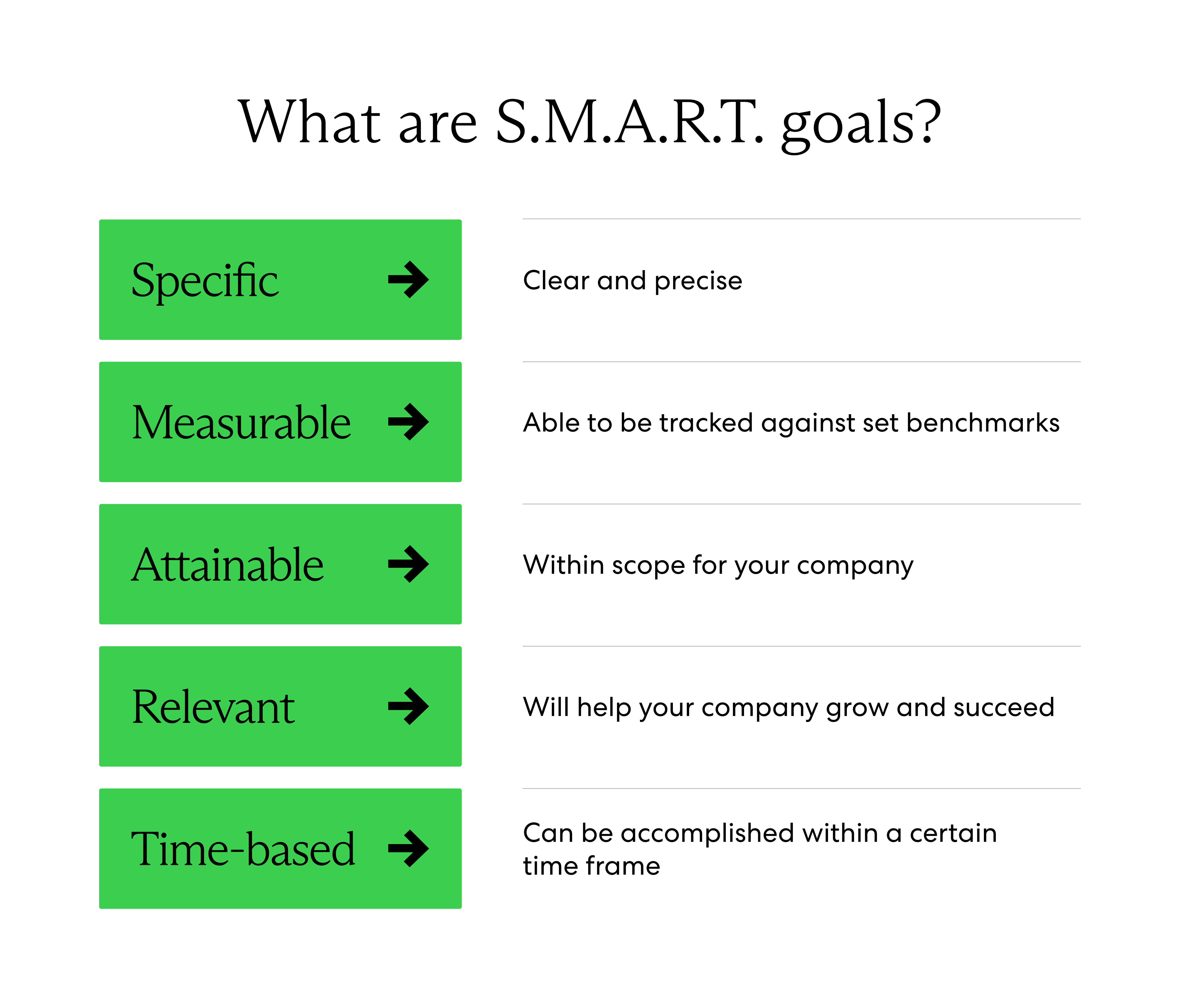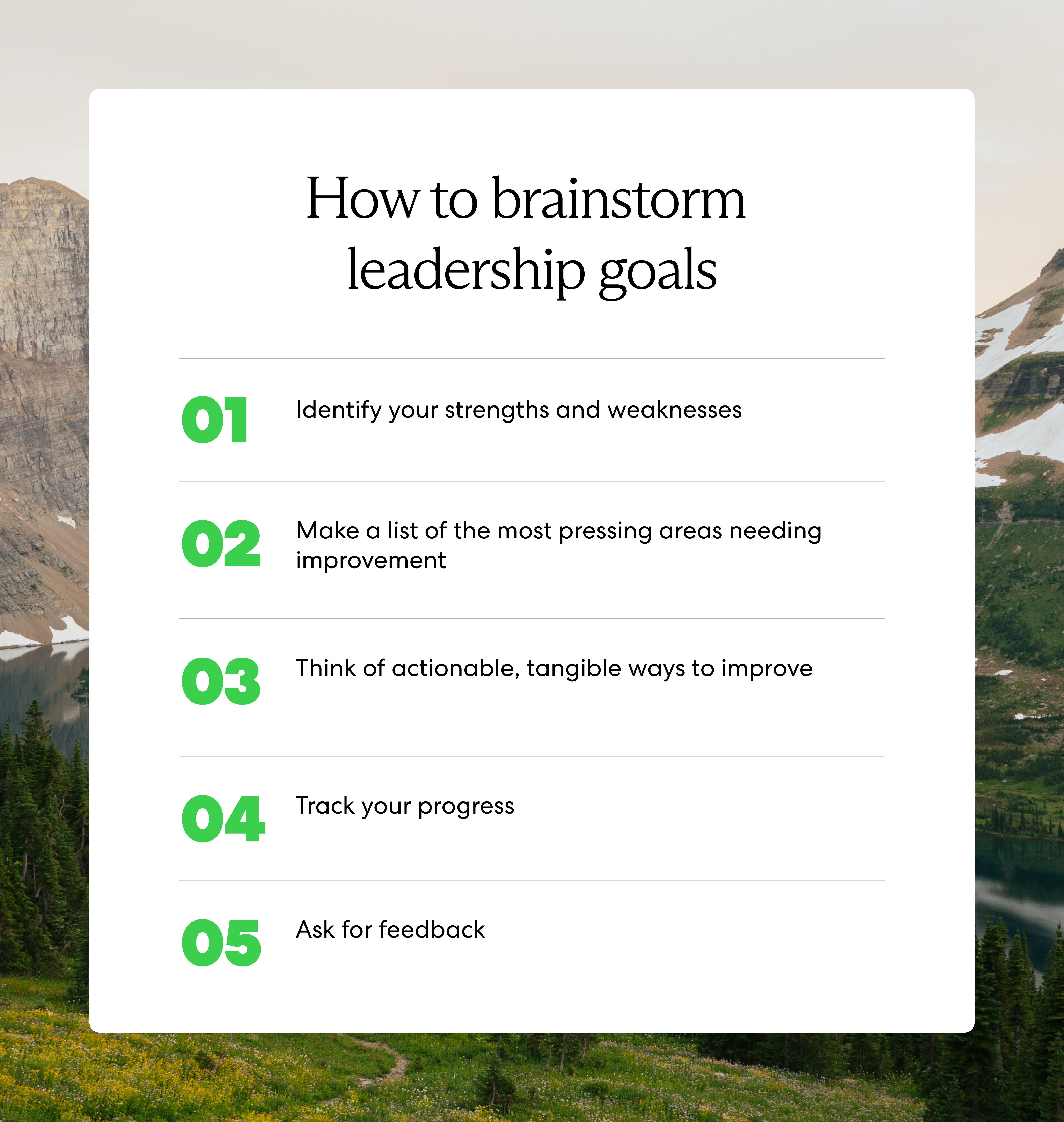The best team leaders all have one thing in common: They put leadership goals in place.
It’s important for leaders to set goals for themselves so they can improve on the skillsets they already have. Setting specific, measurable, attainable, relevant, and time-based (SMART) goals can help leaders create an actionable plan to grow and succeed.
But with so much to do, entrepreneurs may stop seeing the value of personal learning and development. In reality, setting goals for your own leadership and management style can help you grow alongside your company.
To help you become the best leader you can be, we’ve compiled 15 leadership goals and objectives with SMART examples that every leader should aim for.
15 SMART leadership goals

The following examples of leadership goals and objectives include ways to develop your professional and emotional well-being.
1. Become more adaptable to change
Adaptability in the workplace is more critical now than ever. Leaders must be prepared for every change in the business world. Especially so, they must be willing to adapt to the changing talent landscape amid the rise of remote work.
Today, talent desires global mobility. They want work-from-anywhere policies, life-work balance, and flexible schedules. Great business leaders adjust their workforce model to serve the changing needs of today's talent in order to reap the long-term benefits of lower employee turnover, improved morale, and better business success.
SMART goal example: Survey your team to understand the changes they want to see in the workplace, then make those changes where feasible. Maybe that means allowing employees to work from home or adjusting your employee rewards packages to include free access to mental health resources.
2. Learn to listen
The greatest leaders are often the best listeners, though listening doesn’t always just mean hearing what someone is saying. On a typical business day, 45% of the day is spent listening, but most humans only listen at a 25% comprehension rate.
Great leaders practice active listening, which means taking intentional steps to comprehend and digest what is being said. This will help you know what is going on around the office, which members of their team have certain skills, and personal conflicts in their team's lives that could impact business.
SMART goal example: Schedule meetings with at least one of your direct reports per week to practice active listening.
3. Focus on building relationships
The best leaders often have strong relationships with their direct reports. Building relationships with your team members forms a sense of trust, allows you to learn about their personal strengths and weaknesses, and ultimately improves employee retention.
Strong bonds between a boss and an employee can also foster trust, fun, and inclusiveness in the office. Rather than being the boss that sits in their office all day, be intentional about chatting with your team and making them feel valued.
SMART goal example: Schedule one employee outing, meeting, or group lunch per month to focus on togetherness and relationship building.
4. Be more open-minded
Different team members will have different perspectives, viewpoints, and ideas for the business. Though some might seem unconventional, taking the time to listen to and consider your team’s thoughts can actually end up helping your business grow and thrive. Become more open-minded about how to run your business, talk to your employees, and complete your goals.
SMART goal example: Aim for a 75% “yes” rate on an anonymous survey asking your employees if they feel valued and heard in the office.
5. Learn to take constructive criticism
Great leaders know how to take constructive criticism, which helps them become even better at their job. In a study by LinkedIn, 92% of people said that constructive criticism is effective at improving performance. When a leader is given upward feedback, specifically from their team, they can make tangible and relevant improvements to their workplace’s day-to-day, boosting morale and performance.
SMART goal example: Increase the number of employees who provide upward feedback by 20%, showing your employees are comfortable doing so.
6. Practice confidence
A little bit of confidence can inspire your team to follow you while helping you make smart decisions. Teams are more likely to follow confident leaders. But don’t fret if you struggle to act or feel confident: You can work on building confidence by repeating mantras to yourself, making lists of your strong managerial qualities, and practicing mindfulness.
SMART goal example: Make a list of five of your strengths or work wins per week in a personal journal or digital document.
7. Build emotional intelligence

To put it simply, emotional intelligence is the ability to recognize, regulate, and handle your emotions. As a leader, emotional intelligence can help you keep your cool in potentially tense situations and keep the peace within your team. Rather than immediately reacting when emotions are high, emotional intelligence is the ability to work through feelings and communicate them calmly.
This leadership skill is important to employees, and luckily 74% of them report that they feel their boss demonstrates a high level of emotional intelligence.
SMART goal example: Write in a journal for 20 minutes at the end of each workday to work through any pain points or lessons learned.
8. Learn your limits
Don’t overdo it. It is something we hear our whole lives yet rarely take into consideration. The best leaders know their limits and don’t push them. Learn to delegate tasks to your employees and trust that they will complete them successfully. This will establish trust with your employees while taking some work off your plate.
SMART goal example: Delegate two low-level tasks to one of your direct reports per week.
9. Discover your team members’ personal strengths
Knowing your employees' strengths and weaknesses allow you to distribute tasks most effectively. Make it a goal to evaluate each team member’s work for their strengths and assign them tasks that utilize them in the most efficient way. This will allow work to get done more effectively while making team members feel appreciated.
Plus, your team members will most likely enjoy their jobs more if they feel they are excellent at their tasks.
SMART goal example: Send out a survey asking employees about their strengths and pain points at work once per quarter.
10. Be a coach
More than just being a boss, leaders should work to uplift their team members. You can do this by becoming a mentor or coach instead of being seen as just the business leader. To do this, work to provide training sessions and schedule meeting times to help your employees advance and grow.
Sharing your expertise with your team can help your employees become better at their jobs while also feeling like a valuable asset to the company. And it won’t fall on unwilling ears, as 79% of people reported actively seeking out opportunities to learn new things at work.
SMART goal example: Schedule a biweekly training session for your team members where you will share your expertise and offer advice.
11. Give positive feedback more often
It can be easy to get lost in the weeds with business tasks and a seemingly endless list of to-dos. But rather than focus solely on delegation, edits, and critiques, make time for positive feedback, gratitude, and congratulations. Taking time to appreciate the work your employees are doing can help them feel more valued and seen at work.
SMART goal example: Set up a Slack channel or weekly email to share employee wins and successes with the team and send out at least three shout-outs per week.
12. Develop a growth mindset
A growth mindset is the ability to realize that challenges or setbacks aren’t permanent. Instead, it’s recognizing these struggles as opportunities to learn, grow, and become an even better manager than you were before. This can be helpful for leaders of businesses or big teams — a growth mindset can keep you working on innovating and growing your business.
SMART goal example: Attend two networking events per quarter and make it a goal to establish at least one connection at each.
13. Practice time management
You can’t expect your employees to stick to deadlines that you don’t stick to yourself. Time management can help you meet your own deadlines to further your business goals, but also sets a good example for your team members to do the same. Especially important for managers who may be in charge of multiple projects at once, good time management is a helpful tool for all leaders.
SMART goal example: Commit to ending meetings on time or even early, making sure meetings never run late.
14. Micromanage less
Business leaders may feel like their business is the most important thing in their lives and want to protect it. For some, this means overseeing every aspect of business operations and the work people are completing. But this ignores the valuable perspectives and processes your team can bring to the table.
Constant micromanagement can lead to tension between boss and employee — especially as 69% of employees say they considered changing jobs because of it — so it’s important for business leaders to make delegation a priority. It’s a win-win: Your team will appreciate the trust, and you can get back to important tasks on your plate.
SMART goal example: Reduce check-ins with employees about ongoing work and commit to only following up once per week or once the project is late or completed.
15. Build a dynamic team
Team leaders should put an immediate focus on building the most well-rounded and efficient team they can. This could mean hiring a diverse or global workforce, pairing new groups of people together, and emphasizing new perspectives and thought processes. A dynamic team is both a business asset and a workplace comfort boon—good leaders should make note of the importance of eclectic teams.
SMART goal example: Implement blind hiring practices in your HR department and work to fully eliminate biases in the hiring process.
How to write leadership goals

Though it can be difficult to look in the mirror and identify pain points, doing so can be essential for business success. To start writing your own SMART leadership goals and objectives, begin with the following steps:
- Identify your own strengths and weaknesses. You’ll want to hone in on areas that actually need improvement, so start by thinking about ways you can improve and areas where you feel confident in your success.
- Select the most important pain points. Identify the most relevant or pressing pain points in your office and make a list of them to get a better handle on the exact things you’re going to target with your goal-setting.
- Think of tangible ways to meet goals. “I want to improve employee communication” is vague, but “I want to hold bi-weekly employee events to facilitate bonding” is an actionable statement. Brainstorm ways to actually meet and measure your goals and improvement.
- Create benchmarks for achieving your goals. Long-term goals can feel overwhelming. Break goals into smaller chunks so that you can track your progress and measure your success as you go.
- Ask for feedback. The purpose of goal-setting is to improve your office. Ask for feedback from your colleagues and direct reports as you work on self-improvement.
Think SMART and set leadership goals
Goals are set by leaders to improve themselves so they can improve their teams in turn. From learning how to be an active listener to adapting to the ever-changing needs of today's talent, these goals help managers lead better and make employees feel valued.
The best leaders set SMART goals that help them build strong teams. What does today's talent value at work? Download our guide to discover talent's expectations for a great working experience, as well as strategies for future-proofing your hiring and retention strategies.
Or for more help navigating effective leadership and the business world, Velocity Global’s full suite of employment solutions can help you lead teams across borders. Our Global Work Platform™ allows you to hire and manage talent in more than 185 countries. Contact us to learn more.





